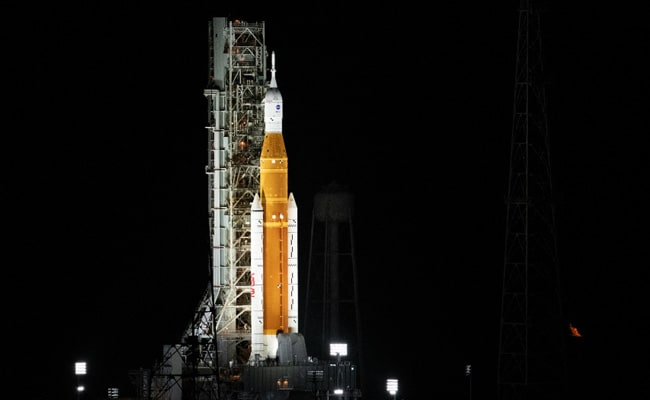Cape Canaveral (US), Sep 3: NASA's new moon rocket sprang another hazardous leak on Saturday, as the launch team began fuelling it for liftoff on a test flight that must go well before astronauts climb aboard.
For the second time this week, the launch team began loading nearly 1 million gallons of fuel into the 322-foot (98-metre) rocket, the most powerful ever built by NASA. Monday's attempt was halted by a bad engine sensor and leaking fuel.
As the sun rose, an over-pressure alarm sounded and the tanking operation was briefly halted, but no damage occurred and the effort resumed. But minutes later, hydrogen fuel began leaking from the engine section at the bottom of the rocket.
NASA halted the operation, while engineers scrambled to plug what was believed to be a gap around a seal in the supply line.
The countdown clocks continued ticking toward an afternoon liftoff; NASA had two hours on Saturday to get the rocket off.
NASA wants to send the crew capsule atop the rocket around the moon, pushing it to the limit before astronauts get on the next flight.
If the five-week demo with test dummies succeeds, astronauts could fly around the moon in 2024 and land on it in 2025. People last walked on the moon 50 years ago.
Forecasters expected generally favourable weather at Kennedy Space Centre, especially toward the end of the two-hour afternoon launch window.
On Monday, hydrogen fuel escaped from elsewhere in the rocket. Technicians tightened up the fittings over the past week, but launch director Charlie Blackwell-Thompson stressed that she wouldn't know whether everything was tight until Saturday's fuelling.
Even more of a problem on Monday, a sensor indicated one of the rocket's four engines was too warm, but engineers later verified it actually was cold enough.
The launch team planned to ignore the faulty sensor this time around and rely on other instruments to ensure each main engine was properly chilled.
Before igniting, the main engines need to be as frigid as the liquid hydrogen fuel flowing into them at minus-420 degrees Fahrenheit (minus-250 degrees Celsius).
If not, the resulting damage could lead to an abrupt engine shutdown and aborted flight.
Mission managers accepted the additional risk posed by the engine issue as well as a separate problem: cracks in the rocket's insulating foam. But they acknowledged other problems like fuel leaks could prompt yet another delay.
That didn't stop thousands from jamming the coast to see the Space Launch System rocket soar. Local authorities expected massive crowds because of the long Labour Day holiday weekend.
The USD 4.1 billion test flight is the first step in NASA's Artemis programme of renewed lunar exploration, named after the twin sister of Apollo in Greek mythology.
Twelve astronauts walked on the moon during NASA's Apollo program, the last time in 1972.
Artemis years behind schedule and billions over budget aims to establish a sustained human presence on the moon, with crews eventually spending weeks at a time there. It's considered a training ground for Mars.
Let the Truth be known. If you read VB and like VB, please be a VB Supporter and Help us deliver the Truth to one and all.
Bengaluru (PTI): The Karnataka government has issued directions to municipal corporations across the state to regulate and prohibit feeding pigeons in public places, citing serious public health concerns.
Deputy Secretary to Government V Lakshmikanth has written to the Urban Development Department requesting it to issue directions to the Greater Bengaluru Authority (GBA) and all municipal corporations to take immediate steps to implement the measures.
In an official note dated December 16 issued by the Health and Family Welfare Department and released to the media on Wednesday, the department said uncontrolled feeding of pigeons in public places has resulted in large congregations of birds, excessive droppings and serious health concerns, particularly respiratory illnesses linked to prolonged exposure to pigeon droppings and feathers such as hypersensitivity pneumonitis and other lung diseases.
ALSO READ: Chinese GPS tracker found on seagull near Karwar Coast
"The commissioner, the Greater Bengaluru Authority and the Commissioners and chief officers of other municipal corporations shall take necessary action to mitigate the causes of dangerous disease spread by pigeon and enforce specified guidelines in their respective jurisdiction," the note said.
According to the department, these include a prohibition on feeding pigeons or causing pigeons to be fed in areas where it may cause nuisance or pose a health hazard to the public. Pigeon feeding shall be permitted only in designated areas in a controlled manner, subject to certain conditions.
"The designated areas may be selected in consultation with stakeholders. The responsibility for upkeep of the designated areas and compliance to the directions shall be taken up by some charitable organisation or an NGO. The feeding in designated areas shall be permitted only for some limited hours in the day," it said.
The note further stated that authorised officers of local authorities shall issue on-the-spot warnings and may impose fines for violation of the order, or lodge complaints to prosecute offenders under Sections 271 (Negligent act likely to spread infection of disease dangerous to life) and 272 (Malignant act likely to spread infection of disease dangerous to life) of the Bharatiya Nyaya Sanhita.
It also directed local authorities to conduct public awareness campaigns, including the display of signboards, banners and digital messages, explaining the health hazards associated with pigeon droppings and feathers, the content of the regulatory directions and penalties for violations, and alternative humane methods of bird conservation that do not endanger public health.





